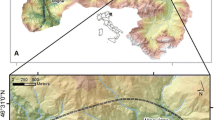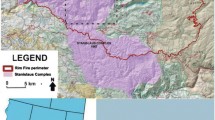Abstract
Quantitative risk assessments (QRAs) for landslide hazards are increasingly being executed to determine an unmitigated level of risk and compare it with risk tolerance criteria set by the local or federal jurisdiction. This approach allows urban planning with a scientific underpinning and provides the tools for emergency preparedness. Debris-flow QRAs require estimates of the hazard probability, spatial and temporal probability of impact (hazard assessment) and vulnerability of the elements at risk. The vulnerability term is perhaps the most difficult to estimate confidently because (a) human death in debris flows is most commonly associated with building damage or collapse and is thus an indirect consequence and (b) the type and scale of building damage is very difficult to predict. To determine building damage, an intensity index (I DF) was created as the product of maximum expected flow depth d and the square of the maximum flow velocity v (I DF = dv 2). The I DF surrogates impact force and thus correlates with building damage. Four classes of building damage were considered ranging from nuisance flood/sedimentation damage to complete destruction. Sixty-six well-documented case studies in which damage, flow depth and flow velocity were recorded or could be estimated were selected through a search of the global literature, and I DF was plotted on a log scale against the associated damage. As expected, the individual damage classes overlap but are distinctly different in their respective distributions and group centroids. To apply this vulnerability model, flow velocity and flow depth need to be estimated for a given building location and I DF calculated. Using the existing database, a damage probability (P DF) can then be computed. P DF can be applied directly to estimate the likely insurance loss or associated loss of life. The model presented here should be updated with more case studies and is therefore made openly available to international researchers who can access it at http://chis.nrcan.gc.ca/QRA-EQR/index-eng.php.





Similar content being viewed by others
References
Aleotti P, Polloni G (2003) Two-dimensional model of the 1998 Sarno debris flows (Italy): preliminary results. Debris-flow hazards mitigation: mechanics, prediction, and assessment; 2003 ISBN 90 77017 78 X
Armanini A (1997) On the dynamic impact of debris flows. Recent developments on debris flows. Lecture Notes in Earth Sciences, 64. Springer, Berlin
Beaupre MM (2009) Structural damage due to the impact pressure generated by the 2005 Berkeley debris slide, located in North Vancouver, B.C. UBC B.A.Sc. Thesis
BGC Engineering Inc. (2003) Preliminary debris flow hazard assessment Hatzic valley. Provincial emergency program. Prepared for the Ministry of Environment. ftp://ftp.for.gov.bc.ca/DCK/external/%21publish/Stewardship/Hydrology_Terrain%20Stability/Hatzic/Reports/BGC%20Engineering%20Hatzic%20Valley%20Report%202003.pdf
BGC Engineering Inc (2010) Mosquito Creek debris flow flood: quantitative risk and mitigation option assessment. District of North Vancouver. Accessed via http://www.dnv.org
Blais-Stevens A, Septer, D (2008) Historical accounts of landslides and flooding events along the Sea to Sky Corridor, British Columbia, from 1855–2007. Geological Survey of Canada 48–49 pp. 62–68 pp. 71–73 pp
Borter P (1999) Risikoanalyse bei gravitativen Naturgefahren, Bundesamt für Umwelt. Wald und Landschaft, Bern, p 1999
Bovis MJ, Dagg BR (1992) Debris flow triggering by impulsive loading: mechanical modelling and case studies. Can Geotech J 29:345–352
Catane SG, Cabria HB, Tomarong CP Jr, Saturay RM Jr, Zarco MA, Pioquinto WC (2007) Catastrophic Rockslide-debris avalanche at St. Bernard, Southern Leyte, Philippines. J Int Consort Landslides 4(1):85–90
Chen JH, Lee CF (2007) Landslide mobility analysis using Modflow. The 2007 international forum on landslide disaster management; ISBN 978-962-7619-30-7
Chen NS, Li TC, Gao YC (2005a) A great disastrous debris flow on 11 July 2003 in Shuikazi Valley, Danba County, Western Sichuan, China. Landslides 2:71–74
Chen N, Li T, Gao Y (2005b) A great disastrous debris flow on 11 July 2003 in Shuikazi Valley, Danba County, Western Sichuan, China. J Int Consort Landslides 2(1):71–74
Chou HT, Liao WM, Lin ML (2000) Landslide induced debris-flow at a dump site. Debris-flow hazards mitigation: mechanics, prediction, and assessment; 2000. ISBN 90 5809 149 X
Chow VT (1959) Open channel hydraulics. McGraw hill, New York 680 p
Conedera M, Peter L, Marxer P, Forster F, Rickenmann D, Re L (2003) Consequences of forest fires on the hydrogeological response of mountain catchments: a case study of the Riale Buffaga, Ticino, Switzerland. Earth Surf Proc Land 28:117–129
Evans SG, Bishop N, Smoll LF, Murillo PV, Delaney KB, Oliver-Smith A (2009) A re-examination of the mechanism and human impact of catastrophic mass flows originating on Nevado Huascaran, Cordillera Blanca, Peru in 1962 and 1970. Eng Geol 108:96–118
Fell R, Hartford D (1997) Landslide risk management. In: Cruden D, Fell R (eds) Landslide risk assessment. Balkema, Rotterdam, pp 51–109
FEMA (Federal Emergency Management Agency) (2003) www.fema.gov/plan/prevent/Hazus/index.shtm
Fuchs S, Heiss K, Hübl J (2007) Towards an empirical vulnerability function for use in debris flow risk assessment. Nat Hazards Earth Syst Sci 7:495–506
Garcia-Martinez R, Lopez JL (2005) Debris flow of December 1999 in Venezuela. In: Jakob M, Hungr O (eds) Debris-flow hazards and related phenomena. Praxis. Springer, Berlin 519 pp
Haeberli W, Huggel C, Kaa A, Zgraggen-Oswald S, Polkvoj A, Galushkin I, Zotikov I, Osokin N (2004) The Kolka-Karmadon Rock/Ice Slide of 20 September 2002: an extraordinary event of historical dimensions in North Ossetia, Russian Caucasus. J Glaciol 50(171):533–546
Hancox GT (2003) Preliminary report on landslides, gully erosion, and debris flood effects in the Paekakariki area as a result of the 3 October 2003 flood. Institute of Geological and Nuclear Sciences Limited. Institute of Geological and Nuclear Sciences client report 2003/120. Project No. 430W1094. 19 pp. http://geonet.org.nz/content/download/7524/44019/file/report4.pdf
Haugen ED, Kaynia AM (2008) Vulnerability of structures impacted by debris flow. Landslides and Engineered Slopes—Chen et al. (eds), pp 381–387
Hsu SM, Chiou LB, Lin GF, Chao CH, Wen HY, Ku CY (2010) Applications of simulation technique on debris flow hazard zone delineation: a case study in Hualien County, Taiwan. Nat Hazards Earth Syst Sci 10:535–545
Hübl J, Holzinger G (2003) Kleinmassstäbliche Modellversuche zur Wirkung von Murbrechern, WLS Report 50, Band 3, Universität für Bodenkultur, Wien
Hungr O, Morgan GC, Kellerhals R (1984) Quantitative analysis of debris torrent hazards for design of remedial measures. Can Geotech J 21:663–677
Jakob M (2005) A size classification for debris flows. Eng Geol 79:151–161
Jakob M, Anderson D, Fuller T, Hungr O, Ayotte D (2000) An unusually large debris flow at Hummingbird Creek, Mara Lake, British Columbia. Can Geotech J 37:1109–1125
Kherkheulidze II (1976) Estimation of basic characteristics of mud flows (“sels”). In: Proceedings of the Leningrad symposium august 1967, international association of scientific hydrology (IAHS) studies and reports in hydrology, No. 3, Vol. 2, pp 940–948
Kong J, Chen Z, Song S (2006) Occurrence conditions and process analysis on fluidization of valley type landslide: example of the fluidization of landslide in Qiongshan Ravine, Danba. Wuhan Univ J Nat Sci 11(4):829–834
McDougall S, Boultbee N, Hungr O, Stead D, Schwab JW (2006) The Zymoetz River landslide and dynamic analysis of a rock slide-debris flow. J Int Consort Landslides 3(3):195–204
McSaveney MJ, Davies TRH (2005) Engineering for debris flows in New Zealand. In: Jakob M, Hungr O (eds) Debris-flow hazards and related phenomena. Praxis. Springer, Berlin 651 pp
Medina V, Hürlimann M, Bateman A (2008) Applications of FLATModel, a 2D finite volume code, to debris flows in the Northeastern Part of the Iberian Peninsula. J Int Consort Lands 5(1):127–142
Mueller R, Loew S (2009) Predisposition and cause of the catastrophic landslides of August 2005 in Brienz (Switzerland). Swiss J Geosci 1–14
Nakagawa H, Takahashi T, and Satofuka Y (2000) A debris-flow disaster on the fan of the Harihara River, Japan. Debris-flow hazards mitigation: mechanics, prediction, and assessment; 2000. ISBN 90 5809 149 X
Ni H, Zheng W, Li Z, Ba R (2010) Recent catastrophic debris flows in Ludig County: geological hazards, rainfall analysis, and dynamic characteristics. Nat Hazards 55:523–542
Rapp A, Li J, Nyberg R (1991) Mudflow disaster in mountainous areas. Ambio 20(6):210–218
Revellino P, Hungr O, Guadagno FM, Evans SG (2004) Velocity and runout simulation of destructive debris flows and debris avalanches in pyroclastic deposits, Campania Region, Italy. Env Geol 45:295–311
Rickenmann D (1999) Empirical relationships for debris flows. Nat Hazards 19:47–77
Scott KM (2000) Precipitation-triggered debris-flow at Casita Volcano, Nicaragua: implications for mitigation strategies in Volcanic and tectonically active Steeplands. Debris-flow hazards mitigation: mechanics, prediction, and assessment; 2000. ISBN 90 5809 149 X
Suwa H (2003) Repetition of debris flows on sunny days at a torrent in Karakorum. Debris-flow hazards mitigation: mechanics, prediction, and assessment; 2003. ISBN 90 77017 78 X
Suwa H, Nakaya S (2007) Two catastrophic debris avalanches triggered by rainstorms in Japan and Philippines. In: Debris-flow hazards mitigation: mechanics, prediction, and assessment, Chen and Major, eds; 341–351 pp
Suwa H, Yamakoshi T (2000) Estimation of debris-flow motion by field surveys. debris-flow hazards mitigation: mechanics, prediction, and assessment; 2000. ISBN 90 5809 149 X
Thurber Consultants Ltd (1983) Debris torrent and flooding hazards: Highway 99, Howe Sound. Prepared for Ministry of Transportation. April 1983
Totschnig R, Sedlacek W, Fuchs S (2011) A quantitative vulnerability function for fluvial sediment transport. Nat Hazards 58(2):681–703
Toyos G, Oppenheimer C, Pareschi MT, Sulpizo R, Zanchetta G, Zuccaro G (2003) Building damage by debris flows in the Sarno Area, Southern Italy. Debris-flow hazards mitigation: mechanics, prediction, and assessment; 2003. ISBN 90 77017 78 X
Tropeano D, Turconi L, Rosso M, Cavallo C (2003) The October 15, 2000 Debris Flow in the Bioley Torrent, Fenis, Aosta Valley, Italy—Damage and Processes. Debris-Flow Hazards Mitigation: Mechanics, Prediction, and Assessment; 2003. ISBN 90 77017 78 X
Utah Geological Survey (2002) September 12, 2002, Fire-related debris flows East of Santaquin and Spring Lake. Utah County, Utah
VanDine DF, Rodman RF, Jordan P, Dupas J (2005) Kuskonook Creek, an example of a debris flow analysis. J Int Consort Landslides 2(4):257–265
Wang CX, Esaki T, Li S (2008) GIS-based two-dimensional numerical simulation of rainfall-induced debris flow. Nat Hazards Earth Syst Sci 8:47–58
Wigmosta MS (1983) Rheology and flow dynamics of the Toutle debris flows from Mt. St. Helens. M.Sc. thesis, University of Washington, Seattle, pp 184
Xu Q, Fan X, Huang R, Yin Y, Hou S, Dong X, Tang M (2010) A catastrophic rockslide-debris flow in Wulong, Chongqing, China in 2009: background, characterization, and causes. Landslides 7:75–87
Zanchetta G, Sulpizo R, Pareschi MT, Leoni FM, Santacroce R (2004) Characteristics of May 5–6, 1998 volcaniclastic debris flows in the Sarno Area (Campania, southern Italy): relationships to structural damage and hazard zonation. J Volcanol Geotherm Res 133:377–393
Zimmermann MN (2005) Analysis and management of debris-flow risks at Sorenberg (Switzerland). In: Jakob M, Hungr O (eds) Debris flow hazards and related phenomena. Praxis. Springer, Berlin
Acknowledgments
This work was made possible and supported by the Chemical, Biological, Radiological/Nuclear, and Explosives Research and Technology Initiative (CRTI) and the Public Security Technical Program (PSTP)—(Quantitative Risk Assessment Project 09/10-0001SCP), which is managed by the Defence Research and Development Canada—Centre for Security Science and Natural Resources Canada. Comments by Murray Journeay, Nicky Hastings, Rejean Couture, Scott McDougall and two anonymous reviewers are acknowledged.
Author information
Authors and Affiliations
Corresponding author
Rights and permissions
About this article
Cite this article
Jakob, M., Stein, D. & Ulmi, M. Vulnerability of buildings to debris flow impact. Nat Hazards 60, 241–261 (2012). https://doi.org/10.1007/s11069-011-0007-2
Received:
Accepted:
Published:
Issue Date:
DOI: https://doi.org/10.1007/s11069-011-0007-2




